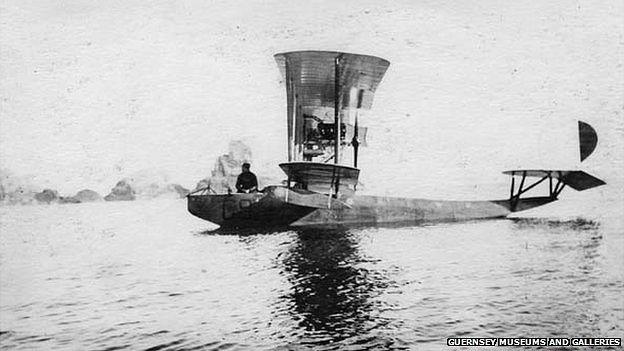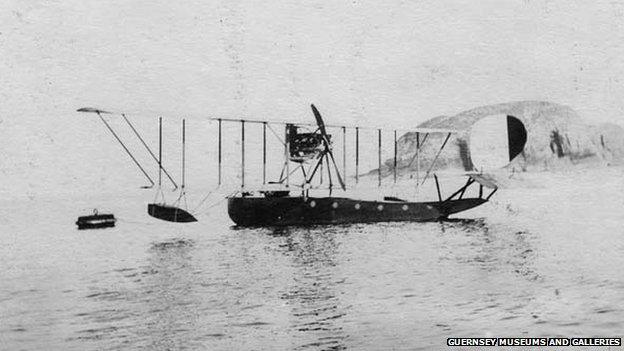WW1 submarine hunters: French seaplane base in Guernsey
- Published

The seaplanes could carry two bombs, which were originally dropped by hand, and carry up to three crew
The building of large hangars and arrival of foreign servicemen would normally make the Guernsey newspapers.
However, voluntary censorship meant the work of the submarine-hunting French seaplane base was kept secret throughout World War One.
Established in August 1917, the base was credited with the destruction of 25 German submarines and discovering three minefields and received the Croix de Guerre.
Just a year after it had appeared though the base was closed, and six months on all the buildings had been removed and life in the harbour returned to normal.
Historian Liz Walton said: "They brought it over in kit form in big boxes... most of the planes certainly came in in kit form, they brought them on barges from Cherbourg.
"[After the armistice] they just packed them all up and took them away again apart from some of the sheds and packing cases, which were auctioned off and brought by farmers who used them to house their animals."
Starvation threat
But, the 12 months of its existence proved crucial in combating an attempted blockade by the Germany navy, which had been in place for more than two years.
It had left all British merchant shipping in the waters around Great Britain and Ireland, including the English Channel, under threat of destruction.
The navy had also warned all neutral ships the area was "a war region" and they could be sunk without warning due to accidents of war and the alleged misuse of neutral flags by the British.
As would happen similarly in World War Two, it had resulted in starvation through a lack of imported food, becoming one of the biggest threats to Great Britain.
The country relied heavily on its imperial colonies and the US for its supplies of meat and grain.

The Guernsey company of the Royal Engineers constructed the hangars including the one in the Model Yacht Pond
Blocking this and the steady stream of men and materials being sent across the English Channel to the front lines was behind the move.
The task to enforce it fell to the German submarine fleet, which by the end of 1916 was taking a serious toll on merchant shipping.
In the English Channel, the job of stopping them already involved British and French airships, planes and naval patrol boats.
The introduction of a convoy system for shipping had helped reduce losses - ships heading for French ports in the English Channel joined up at Ushant, an island to the west of Brittany, and travelled along the French coastline.
Seaplanes based along the French coast were already covering the convoys but for one area, that between Treguier and Guernsey, prompting the site of a new island base to be investigated.
By August 1917, it was up and running with 100 French servicemen in the island and 12 seaplanes in action, although both of these numbers would grow.
The biplanes had a single float, their British counterparts had two, could carry a crew of two or three and two bombs on four-hour patrols.
Weather could be a real problem as when fully loaded with bombs and fuel the planes needed a longer run to take off than was available within the harbour and had to brave the swell at the harbour mouth.
Obviously the normal operation of the Guernsey harbour had to continue and the two did not always mix well.
The harbourmaster wrote to some boat owners asking them to move their boats, which have been left "in the way of the seaplanes operating in the harbour".
But, during the whole of the base's existence, there was only one casualty recorded.
'Unfortunate death'
"Monsieur Drouet", as he was described in a Guernsey Evening Press photograph of him relaxing at the island's Hotel de France, was named only as one of a number of "well-known aviators" popular in the island, shortly before his crash death.
The report of his "unfortunate death" did not reveal his military background as a pilot with the rank of petty officer or that he had been flying a French military seaplane to Guernsey.
His visit and those of others led to the building of four large hangars on the Castle Emplacement, including one in the drained Model Yacht Pond.

The airmen escorted convoys from Ushant to the ports along the northern French coast
Among those to be awarded medals was Quartier Maitre (quarter master) Emile Chapin, who received the Medaille Militaire and Croix de Guerre for sinking a submarine in January 1918.
He is reported to have worn them with pride on the day of his wedding to Leah Badaire - the only daughter of the owner of the island's Hotel de France.
Pilot Officer Victor Lambert, who won the Croix de Guerre, later returned to the island as the French Consular agent in the 1960s.
A succession of seaplane companies trying to operate a passenger service to and from the UK and Jersey through the 1920s and 1930s, but most were relatively short lived as the route was not commercially viable.
An airport was built in 1939, but regular commercial services did not start until October 1946 because of the German occupation during World War Two, which ran from 30 June 1940 to 9 May 1945.
What led 100 U-boats to surrender off the coast of Harwich, and what lay behind the headlines about an attack on Lowca, Cumbria?
Colourful makeovers that hid WW1 ships.